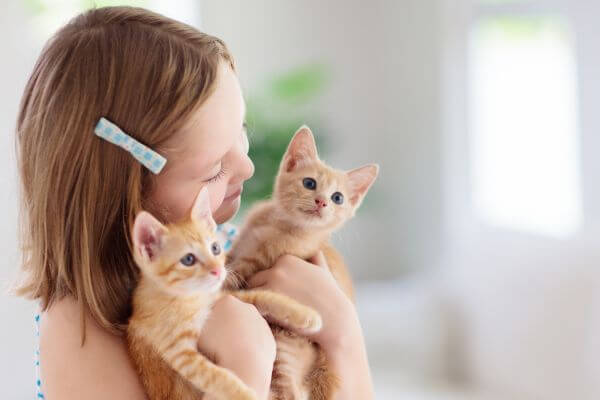This article provides tips and strategies for establishing a harmonious and safe coexistence between cats and children. It is essential to teach children how to approach cats gently and respectfully, while recognizing signs of discomfort or aggression. Supervision and setting boundaries are crucial, as well as teaching proper handling techniques. Additionally, promoting responsibility and empathy in children, while ensuring safety precautions, helps strengthen the bond between both parties and create a harmonious environment.

I. Introducing Cats and Children:
Introducing cats and children requires careful consideration to ensure a positive start. Begin by teaching children the importance of approaching cats gently and respectfully. Show them how to extend a hand for the cat to sniff and let the cat initiate contact. Emphasize the significance of avoiding rough play, pulling tails, or bothering cats when they show signs of discomfort.
Introducing cats and children requires careful consideration to ensure a positive start. Begin by teaching children the importance of approaching cats gently and respectfully. Show them how to extend a hand for the cat to sniff and let the cat initiate contact. Emphasize the significance of avoiding rough play, pulling tails, or bothering cats when they show signs of discomfort.
Furthermore, it is crucial to create a calm and peaceful environment during the introduction phase. Encourage children to maintain a quiet demeanor and avoid sudden movements that might startle the cat. Teach them to speak softly and move slowly around the cat, allowing the feline to adjust and feel comfortable in their presence. By setting the foundation for a gentle and respectful approach, you can ensure a positive and harmonious relationship between cats and children from the very beginning.
II. Educating Children about Cat Behavior:
It’s essential to educate children about cat behavior to help them understand their feline companions better. Teach them to recognize signs of fear, stress, or aggression in cats, such as flattened ears, a tucked tail, or hissing. By understanding these cues, children can adjust their behavior accordingly, giving cats the space they need.
Additionally, educating children about cat behavior empowers them to interpret and respond appropriately to their feline companions’ needs. Teach them that cats may exhibit defensive behaviors when they feel threatened or overwhelmed. Help children understand that giving cats space and allowing them to retreat when they need it is crucial for their well-being. By fostering this understanding, children can develop empathy and a deeper appreciation for the unique communication style of cats, paving the way for a harmonious and respectful coexistence.
III. Supervision and Setting Boundaries:
Supervision is crucial when cats and children interact, especially with younger children. An adult should always be present to ensure that interactions remain safe and positive. Establish clear boundaries and rules for both children and cats. Teach children to approach cats calmly and gently, avoiding sudden movements or loud noises that may startle them. Remind them not to disturb cats while they are sleeping or eating and to give cats space when needed.
IV. Teaching Proper Handling Techniques:
Proper handling techniques are vital to prevent accidents and ensure the safety of both cats and children. Teach children how to pick up and hold cats correctly, supporting their hindquarters and keeping a gentle grip. Remind them to never squeeze or restrain cats forcefully and to avoid carrying them by their tails. By teaching these techniques, you empower children to interact with cats in a way that is comfortable and safe for both parties.
V. Teaching Respect for Personal Space:
Respecting a cat’s personal space is crucial for maintaining a harmonious relationship. Teach children to recognize when a cat wants to be left alone and to respect their boundaries. This includes not chasing or cornering cats, giving them space when they retreat to a designated area, and allowing them to come to the child for interaction when they feel comfortable.
VI. Positive Reinforcement and Rewards:
Positive reinforcement is an effective tool for shaping desirable behavior in both cats and children. Encourage children to reward cats for good behavior with gentle praise, treats, or interactive play. This reinforces positive interactions and helps build a stronger bond between cats and children.
VII. Teaching Responsibility and Care:
Caring for a cat is an opportunity to teach children about responsibility and empathy. Assign age-appropriate tasks such as feeding the cat, refilling water bowls, or grooming. This not only instills a sense of responsibility but also strengthens the bond between children and their feline companions. Children learn valuable life skills such as commitment, empathy, and nurturing through caring for their cats.
VIII. Safety Precautions:
Ensuring the safety of both cats and children requires taking necessary precautions. Keep potentially hazardous substances such as cleaning products or medications out of reach of children and cats. Cover electrical cords and secure them to prevent chewing. Teach children not to disturb cats while they are eating or using the litter box, and regularly clean and maintain the litter box to promote good hygiene.
Creating a harmonious and safe coexistence between cats and children requires patience, education, and supervision. By
implementing the tips and strategies outlined in this article, you can foster a positive relationship between cats and children. Remember to introduce cats and children gradually, educate children about cat behavior, set boundaries, teach proper handling techniques, and promote empathy and responsibility. Supervision is essential during interactions, and positive reinforcement helps reinforce good behavior.
Respect for personal space and teaching responsibility are crucial aspects of creating a harmonious environment. Encourage children to respect a cat’s boundaries and teach them age-appropriate tasks related to cat care. By promoting responsibility and empathy, children learn important life skills while strengthening their bond with their feline companions.
In terms of safety, take necessary precautions to ensure the well-being of both cats and children. Keep potentially harmful substances out of reach, secure electrical cords, and teach children about proper behavior around cats during mealtime and litter box use. Remember, every child and cat is unique, and the dynamics of their relationship may vary. It’s important to observe and assess their interactions regularly, making adjustments as needed to ensure a harmonious coexistence.
By fostering a positive relationship between cats and children, you create an environment where both can thrive and learn from each other. This bond can bring immeasurable joy, companionship, and valuable life lessons to both parties involved. Celebrate the joys and unique experiences that arise from the beautiful relationship between cats and children. With the right knowledge, patience, and guidance, you can create a harmonious and safe coexistence, nurturing a lifelong connection between your children and their feline companions.
In conclusion, by following the tips and guidelines provided in this article, you can create an environment where cats and children coexist harmoniously and safely. Through proper introduction, education, supervision, and the promotion of empathy and responsibility, you can foster a strong bond between them. Embrace these tips, and enjoy the wonderful journey of nurturing a harmonious and safe relationship between your beloved feline companions and the children in your life.

